
Ever tried punching water? Your hand glides right through. But if you punch a bowl of cornstarch mixed with water — a goopy mixture called oobleck — you might be surprised to find it feels almost like a solid. That’s because oobleck is a non-Newtonian fluid: a substance that doesn’t follow the usual rules of how liquids behave.
In regular (Newtonian) fluids — like water, juice, or oil — the viscosity, or “thickness,” stays constant no matter how you stir or squeeze them. But in non-Newtonian fluids, viscosity changes depending on the force applied. Push it gently, and it flows like a liquid. Hit it hard, and it resists like a solid. Oobleck is the most famous example, but other everyday examples include ketchup, toothpaste, blood, slime, and even quicksand.
Some non-Newtonian fluids get thicker under stress (called shear-thickening, like oobleck), while others get thinner (called shear-thinning, like ketchup — that’s why you shake the bottle to get it flowing). This quirky behavior has fascinated scientists and engineers for decades. In fact, companies are using non-Newtonian materials to create shock-absorbing gear, body armor, and safer sports equipment — because these fluids can remain soft and flexible until hit with force.
The term “non-Newtonian” comes from Sir Isaac Newton, who defined the “normal” fluid rules back in the 1600s. But these oddball materials break those rules, offering both fun science experiments and serious real-world uses. So the next time you mix cornstarch and water, remember — you’re not just making a mess. You’re playing with physics that defies expectations.
RELATED POSTS
View all
